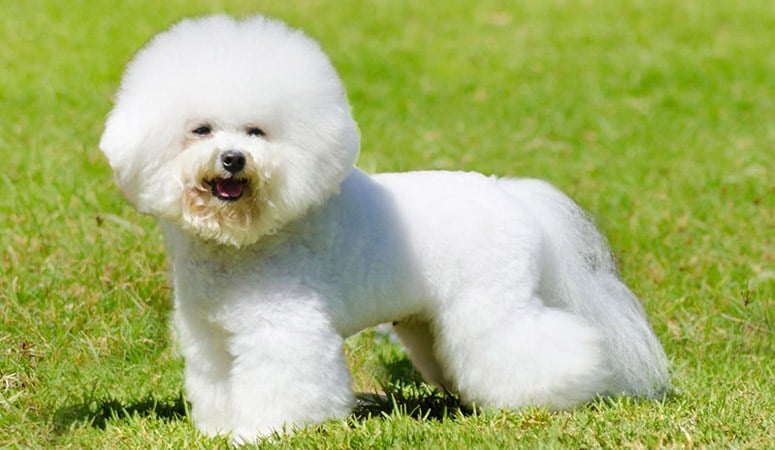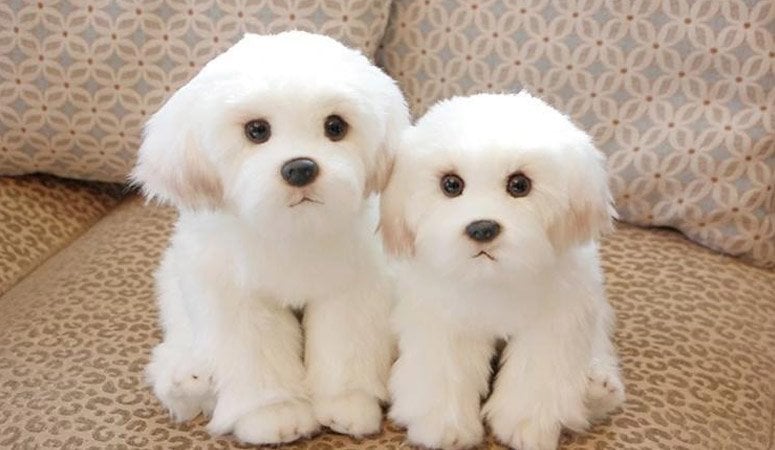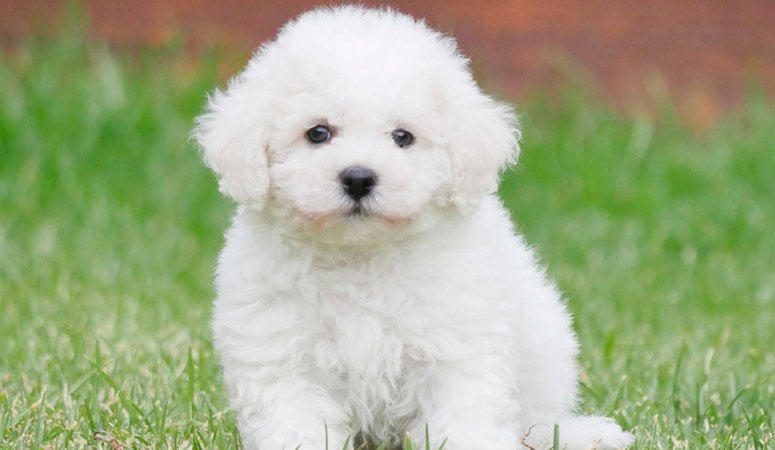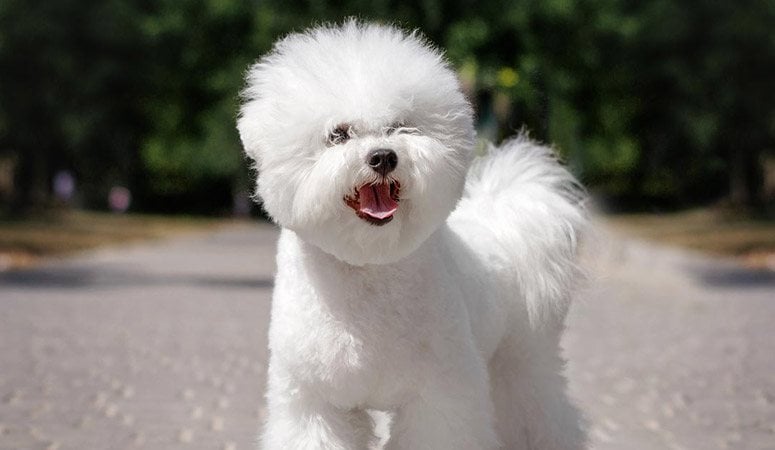Bichon Frise
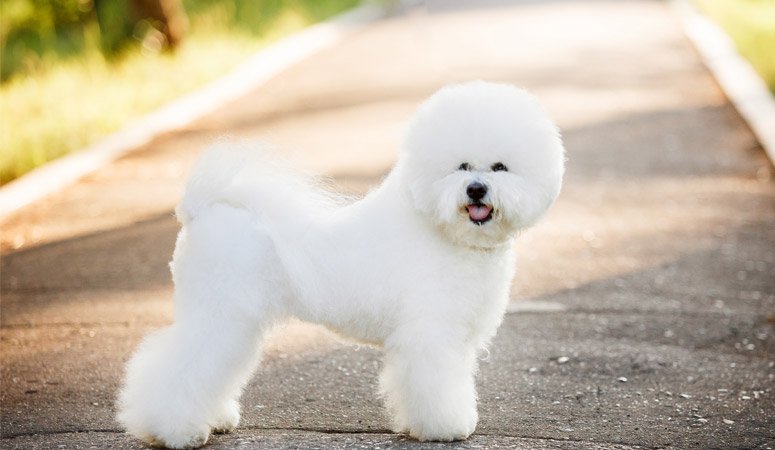
The Bichon Frise is a small dog breed with a fluffy white coat, who looks like a child’s toy. They have a thick coat in loose and curly hair, and they are cheerful, intelligent, and like to show off. Their cute looks and friendly personality make them become popular family companions and pets in the world.
| Other Names | Bichon, Bichon a Poil Frise, Bichon Tenerife, Tenerife |
| Color | White, White & Apricot, White & Buff, White & Cream |
| Height | Males: 9-12 inches. Females: 9-12 inches. |
| Weight | Males: 7-12 pounds. Females: 7-12 pounds. |
| Life Span | 14-15 years |
| Personality | Playful, Curious, Peppy |
| Exercise | Regular Exercise |
| Origin |
| Popularity | #43 |
| Groom Needs | Specialty/Professional |
| Kids Friendly | Yes |
| Dog Friendly | Yes |
| Watch Dog | |
| Family Dog | Yes |
| Litter Size | 4-6 |
Bichon Frise Pictures
Bichon Frise Video
Introduction
One just straight away thinks “cute!” when looking at the Bichon Frise. Only 11.5 inches at the shoulders and weighing in at around 18 pounds, this companion doggy is highly affectionate. His job used to be to entertain people in the circus and he seems to still do that pretty well in these days. He is just a lapful of charm with his cotton wool white hair, loving to be the center of attention. His cousins are the Havanese, Maltese, and Coton de Tulear. Because they are so cute and cuddly , that does not mean they don’t need plenty of attention, exercise, and training. The white cloud of hair requires daily grooming. It is affectionate with children but not if the kids are rambunctious and rough with a small Bichon. They can be easily injured if play gets too rough; then they get snappish and frightened. The Bichon Frise needs a great deal of companionship more than other breeds and does not like being left alone for more than a few hours. If they feel unhappy and lonely they will bark a lot and chew destructively on things.
Living with Bichon Frise
While Bichons Frises shed very little, their double coat grows continually and needs frequent brushing, trimming, grooming, and bathing to remove old hair and prevent matting. They should be brushed at least two or three times a week and daily brushing is the best. Bichons need to visit a professional groomer every four to six weeks to maintain their coat in a good length. And you need to check their ears often to make sure they’re clean. If you find wax buildup, redness, or foul odor from his ears, or your dog scratches his ears and shakes his head, please take him to a vet to make sure if he has infections.
Bichon’s face clean is also important for health as well as looks. Bichons are prone to eye tearing which can stain the face, if you don’t clean the area regularly it may cause eye problems.
Brush their teeth at least two or three times a week to prevent tartar buildup and fight gum disease, and the daily brush is better.
Additionally, trim nails regularly if the dog does not wear down the toenails naturally.
The Bichon Frise is classified as “somewhat active,” but that’s an average. They don’t need hours of activity to tire although they have a moderate energy level. Two walks per day outside for about 30 minutes or running through the house or around the yard are Bichon requires. Additionally, a daily play session is needed to make your dog happy. Other dogs may be a fine exercise companion, but the Bichon Frise will still need quality playtime with his owner.
Taking your Bichon to dog parks can work out well as long as bichons are not expected to mingle with much larger breeds.
Bichons Frise is a food motivated breed that responds well to treats during training. Generally, it is recommended to feed about one cup per day in high-quality dry dog food bases on the dog’s weight, activity level, and age, and the food amount should be divided into two meals. There should be fresh and clean water at all times.
Whole foods including good cuts of meat are great for the Bichon Frise. Be sure that they receive a steady diet of whole, natural food that they are able to enjoy. Bichons tend to stay in good weight, but the thick coat can sometimes obscure weight problems, be sure to use your hands to feel. Don’t overfeed them.
Bichon Frise may be prone to the following conditions: cataracts and eye disease, dental concerns, patellar luxation, skin allergies, heart disease…
Major concerns: Cushing’s, patellar luxation, allergies
Minor concerns: CHD, cataract
Occasionally seen: Legg-Perthes, liver disease
Suggested tests:
Ophthalmologist Evaluation
Patella Evaluation
Hip Evaluation
Total Annual Cost: $2740
Cost is estimated for the first year and may vary depending on many factors, such as dog food, health care, leash, collar, licensing, possible fencing, crates, training and obedience classes, dog-walking, grooming, treats, toys, flea, tick, and heart-worm meds, microchips, etc.
The Bichon may be difficult to housetrain as with most small breed dogs. Bichon needs to be with his family if he is regularly left alone for long periods of time it may cause undesirable behaviors.
Bichons have a reputation for being difficult to housebreak, but they are very easy to train in every other respect. To name only a few, they can learn basic obedience with ease, love to perform tricks, and learn new ones quickly. Also, they respond very well to positive reinforcement, treats, and praise rather than harsh or negative methods.
Early socialization is important to prevent fearful behaviors as some bloodlines are more timid. Keep training sessions fun and interesting, with plenty of praise—and no harsh punishments, Bichons could be trained as service dogs and provide valuable support in this capacity.
History
This little dog has been around for at least 2000 years, but of course, not always known by the name of Bichon.
There have been little white dogs recorded that were found throughout the Mediterranean area, making their way throughout the world. They became very popular and flourished because of their small size and charming, cute ways.
During the Renaissance, they were to be found at the royal court of France, often seen in portraits as companions to fine ladies.
When the 19th century came about, the Bichons had lost a bit of their popularity and they accompanied organ grinders, performing in the streets to the amusement of those who passed by. Some became popular circus dogs. Some of them held important jobs like leading people who were blind, and others had the reputation of being excellent companion dogs.
It was the French breeders who took them in hand in the early 20th century, writing a breeding standard for them, and giving them a new name: Bichon Frise – it means “curly coat.”
Then in 1956, a French family moved to Michigan, bringing their little Bichons with them – that started the breed in the USA. The Bichon Frise Club of America was formed about 10 years later, well in 1964. Then the American Kennel Club recognized the breed in 1973. It’s a popular dog, ranking around 37th amongst all the breeds registered by the AKC, still continuing to be popular and a much-loved dog.
Helpful Information
Breed Club: BICHON FRISE CLUB OF AMERICA, INC.
Breed Club Link: https://bichon.org/
Breed Club Rescue: Bichon Frise Rescue Effort
Breed Club Rescue Link: https://bichonrescue.org/

